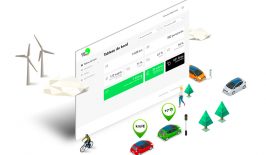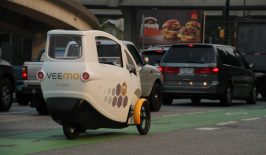The French startup Mobotiq wants to decentralise urban transport – with the help of DIY vehicles and the Ethereum blockchain.
What would a world look like where nobody owned a car anymore? Maybe something like this: If you needed to get somewhere, instead of rummaging for the key, you’d pull out your smartphone and order an autonomous vehicle via an app. Less than three minutes later, it would roll up and drive you anywhere in the city, wherever you wanted. And if you were travelling with friends, the vehicles could interconnect with each other and drive around as a group.
That’s exactly the vision that the startup Mobotiq wants to see become reality. The French company is currently working on a decentralised network of autonomous e-vehicles as a sustainable approach to future mobility. Instead of looking to the state to build the infrastructure, this startup relies on a peer-to-peer network, made up of the community of users. This means that the users themselves become active in the design of the network and how and when it runs, unlike public transport which is organised by the city or community. Rather than just being consumers of public transport, Mobotiq provides a platform which allows them to become prosumers: not just users but also “investors, designers, manufacturers, operators”.
They want to make all of this possible via a sharing network, which is set to be built on the Ethereum blockchain. This technology incentivise the users to organise themselves, building their own vehicles and adapting the system to best suit their own mobility needs. Mobotiq’s slogan is: “design it, build it, make it real”.
An alternative to car ownership
The vehicles that Mobotiq are planning to use are clearly smaller and more efficient than conventional cars. And they’re designed to be easy to maintain and repair too – thanks to their modular, three-wheeled design – which makes them more durable. The three-wheeled prototype has space inside for one or two passengers, but it would also be possible to build other types of vehicles that hold more, as the video below shows.
The startup has not revealed what its own role in a decentralised network like this would look like. It is not the only company that wants to develop autonomous cars, even Google’s sister Waymo and Uber are working on it – albeit not with user-built vehicles.
In any case, it will be quite some time before Mobotiq’s P2P fleet becomes reality: the first test run is set to be carried out in Paris this year, but its success depends solely on its users and whether they really actively participate in the growth of the Mobotiq system. In 2019, the startup wants to put fully functional electric tricycles on the streets that are legally allowed to become part of the traffic. At the same time, it is hoped that users will start producing the electric tricycles themselves. By 2020 the startup hopes to have reached a network of 50,000 peers with 4,000 vehicles in Paris and 30 active vehicle producers.
It remains to be seen whether the incentives, created through the blockchain, are enough to convince users to really build their own vehicles and actually make them available to the community.
One thing is clear, however: whether it’s a self-built e-tricycle or a Tesla, sustainable mobility doesn’t just mean electric vehicles powered by renewable energy sources, it also means rethinking our previous understanding of ownership. And we should only resort to a car (even if it’s electric and part of a sharing scheme) if there’s absolutely no other option. For short trips, there’s still nothing that beats the simple bicycle.
Want to know more about the future of mobility? Then take a look at our E-Mobility special.
This is a translation by Ana Galan of the original article which first appeared on RESET’s German-language site.







